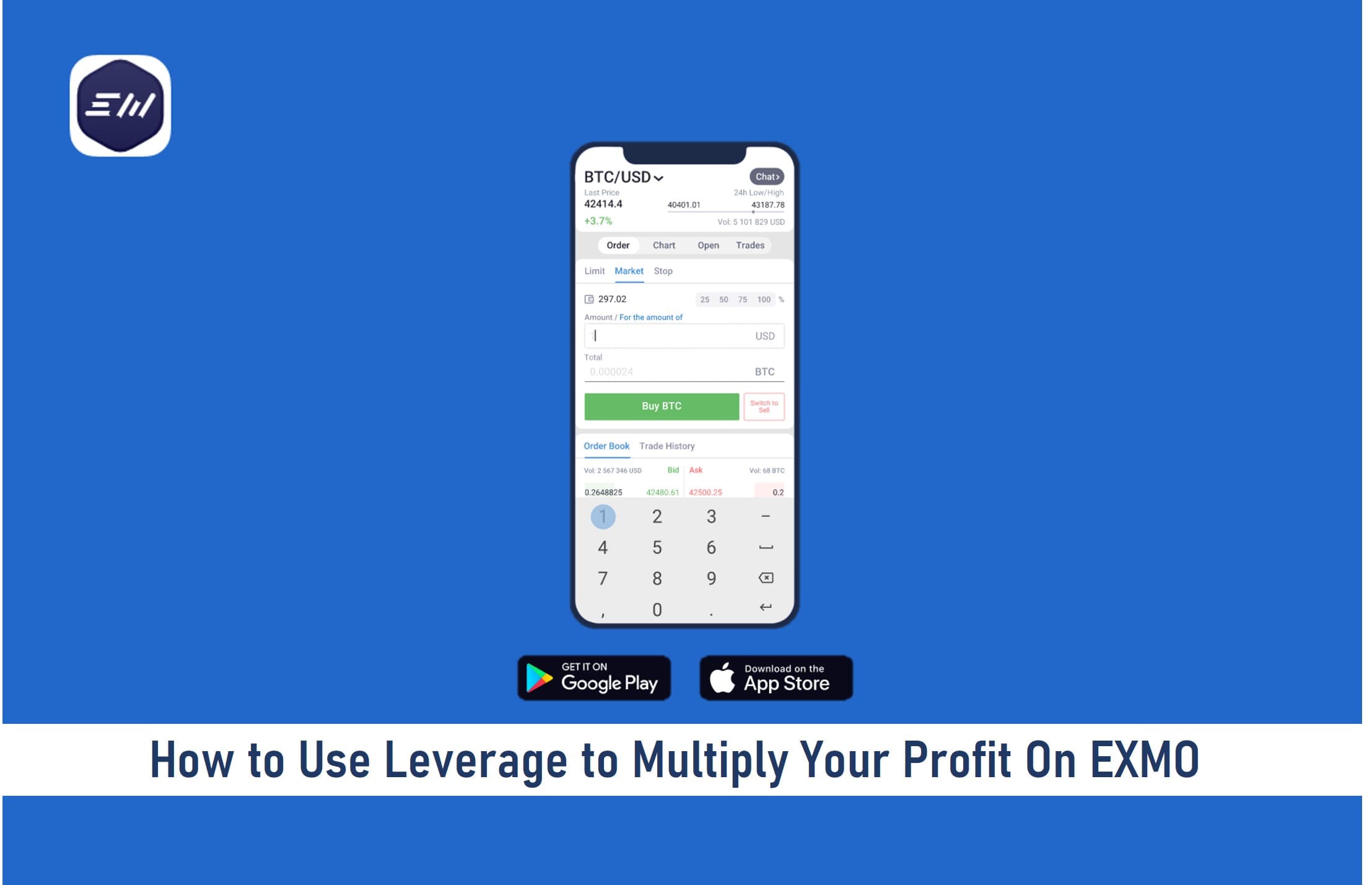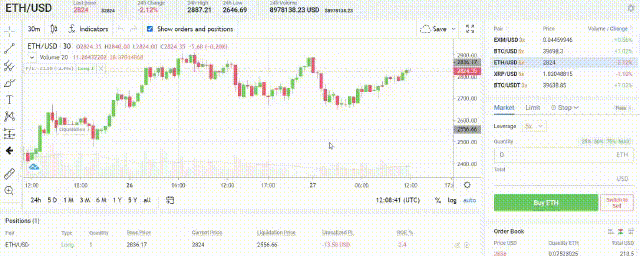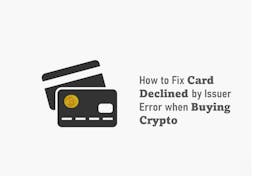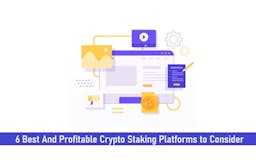
How To Use Leverage To Multiply Your Profit On EXMO
The basic reason why so many investors prefer cryptocurrency to other financial assets is that you can usually achieve considerably larger leverage with cryptos than you can with stocks.
While many traders are familiar with the term “leverage,” few understand what it means, how it works, and how it might affect their crypto investment.
EXMO is one of the best cryptocurrency exchanges that was launched to provide complex hedging positions using high leverage techniques.
The possibility to trade with margins and leverage can be incredibly beneficial for investors starting with a limited quantity of crypto funds, as it magnifies even the slightest successes to be worth a large amount more.
Setting margins allows you to predetermine how much you’re willing to risk for a payoff possibility of up to 100 times that amount. You can utilize it to profit from relatively tiny price swings, ‘gear’ your portfolio for more exposure, or stretch your money.
In this post, we formally discuss how to get the most out of leverage on the EXMO exchange, including how it works, when it’s appropriate to use it, and how to manage your risk.
Key Takeaways
• Leverage is a trading feature that allows you to trade with a considerably higher stake in the market than you put down when you opened the deal.
• CFDs and other leveraged products can equally double your potential profit and loss on an investment.
• Leverage works by increasing your exposure to an underlying asset by using a deposit, known as margin.
• The leverage ratio is the ratio of your entire exposure to your margin.
SEE ALSO: EXMO Withdrawal Fees for Top 10 Crypto Coins
SEE ALSO: FTX Vs. FTX.US – All You Need to Know
SEE ALSO: 10 Best Bitcoin Exchanges With Competitive Transaction Fees
A lot of investors have heard the word leverage, but only a few quite know what it means. Without any further ado, let’s get started with the basics of what leverage is.
What is Leverage?
The term “leverage” refers to trading cryptocurrencies or other financial assets with borrowed funds.
It increases your buying or selling power, allowing you to trade with more money than you have on hand. You could borrow up to 100 times your account balance depending on the crypto exchange you trade on.
A ratio, such as 1:5 (5x), 1:10 (10x), or 1:20, describes the degree of leverage (20x). It indicates how much your starting capital has grown. Consider the following scenario: you have $100 in your exchange account and wish to open a $1,000 bitcoin stake (BTC). Your $100 will be worth $1,000 with a 10x leverage.
Different crypto derivatives can be traded using leverage. Margin trading, leveraged tokens, and futures contracts are only a few examples of leveraged trade.
How Leverage Works
You must first deposit funds into your trading account before you can borrow funds and start trading with leverage.
We refer to the initial capital you offer as collateral.
The amount of collateral you’ll need is determined by the amount of leverage you’re using and the overall value of the position you intend to open known as margin.
For example, you wish to put $1,000 into Ethereum (ETH) and leverage it 10 times. The needed margin is one-tenth of a thousand dollars, which means you must have $100 in your account as security for the borrowed cash.
Your necessary margin would be considerably smaller if you used a 20x leverage (1/20 of $1,000 = $50). However, keep in mind that the larger the leverage, the more likely you are to be liquidated.
You’ll need to have a margin threshold for your trades in addition to the initial margin deposit.
If the market goes against you and your margin falls below the maintenance barrier, you’ll need to put more money into your account to keep it from being liquidated. The maintenance margin is another name for the threshold.
Long and short positions can both benefit from leverage. When you open a long position, you’re betting that the price of an asset will rise. Opening a short position, on the other hand, indicates that you expect the asset’s price will fall.
While this may appear to be conventional spot trading, leverage allows you to purchase or sell assets only based on your collateral, rather than your holding.
If you don’t own an asset, you can borrow one and sell it. Simply start a short position if you believe the market will fall.
Unlike most cryptocurrency exchanges, EXMO allows investors to trade both long and short positions, allowing them to profit from market ups and downs.
How to Trade on EXMO Margin
You can use leverage to trade with bigger volumes at EXMO Margin. You keep all of your profits while only paying a little fee. Here’s how to Get Started with EXMO Margin Trading
Verification and registration
To begin trading on the margin platform, you must first register with the EXMO exchange and authenticate your identification.
A detailed video on how to pass verification has been provided by the platform.
Log into EXMO if you already have a verified account. Then head over to EXMO Margin and sign the User Agreement.
Depositing
You must transfer funds from your EXMO spot wallet to top up your balance. There are no fees for transactions between spot and margin exchange platforms. Please keep in mind that you must already have funds in your account.
To make a deposit, follow these steps:
• Hover over the balance area in the upper right corner of the EXMO margin platform and click “Deposit.”
• The Funds Transfer Agreement must be read and accepted.
• Click the “Deposit” button in the pop-up box and enter the deposit amount.
Opening positions

You can begin trading cryptocurrency with leverage after topping up your account.
Traders typically open long bets to profit from a rising market and short positions to profit from a falling market.
Now, using a long position as an example, let’s look at the margin trading mechanism:
• Choose an order type and a trading pair.
• Set the size of the leverage.
• Click “Buy” after entering the desired quantity of cryptocurrency.
The equivalent in dollars will be presented automatically. After your order is executed, you can track your position in the “Positions” portion of the chart, which shows all open positions.
The important position parameters, such as quantity, base price, current market price, and liquidation price, are displayed in this section.
Liquidating positions
EXMO provides separate margin trading. This means that gains in one place cannot compensate for losses in another.
As a result, you cannot lose more than the amount of margin allotted to this position when it is liquidated.
The collateral necessary to use leverage is known as margin. Simply put, this is the amount on your account that is “frozen” until the position is closed.
These funds ensure that traders will be able to meet their obligations if the market price falls against them.
Margin call and liquidation price

The margin call price is the cost of a margin call, which is a request to add margin to your position.
You’ll get a margin call if you begin a long trade but the price starts decreasing instead of rising, and your margin collateral level drops dramatically. You can add a margin-right on top to avoid liquidation.
The price at which the exchange initiates position liquidation is known as the liquidation price. For example, if the price falls further and the margin level goes below the critical threshold, the platform will liquidate your long position to reduce risk.
Editing and closing positions

You can close a position on the chart by clicking the cross sign when you’re ready to make a profit. You may also adjust your position on the chart by clicking on it. Please note that if you want to automatically close the position, a market order will be placed.
Withdrawal of funds

Withdrawing profits is, of course, the final stage. To do so, you must first transfer dollars to your EXMO account.
Click the “Withdraw” button under the “Balance” section.
Enter the amount you want to withdraw or the percentage of your total balance you want to withdraw in the pop-up box.
Taking money out
The funds will be sent to your spot account practically instantaneously, and the transaction will display in your transaction history.
Final Thoughts
You now understand how to trade with leverage, open and close positions, and withdraw money. To boost your potential profits, trade bitcoin on EXMO Margin.
With leverage, you may get started quickly with a cheaper initial investment and perhaps better profits.
Even so, leverage mixed with market volatility could result in fast liquidations, especially if you’re trading with 100x leverage.
Before engaging in leveraged trading, always exercise prudence and weigh the risks. When employing leverage, you should never trade funds you can’t afford to lose.
Read More




